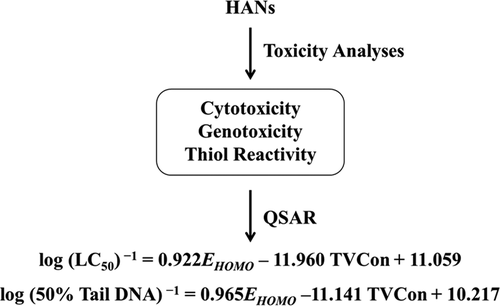当前位置:
X-MOL 学术
›
Environ. Sci. Technol.
›
论文详情
Our official English website, www.x-mol.net, welcomes your feedback! (Note: you will need to create a separate account there.)
Comparative Quantitative Toxicology and QSAR Modeling of the Haloacetonitriles: Forcing Agents of Water Disinfection Byproduct Toxicity.
Environmental Science & Technology ( IF 11.4 ) Pub Date : 2020-06-18 , DOI: 10.1021/acs.est.0c02035 Xiao Wei 1, 2 , Mengting Yang 3 , Qingyao Zhu 3 , Elizabeth D Wagner 2, 4 , Michael J Plewa 2, 4
Environmental Science & Technology ( IF 11.4 ) Pub Date : 2020-06-18 , DOI: 10.1021/acs.est.0c02035 Xiao Wei 1, 2 , Mengting Yang 3 , Qingyao Zhu 3 , Elizabeth D Wagner 2, 4 , Michael J Plewa 2, 4
Affiliation

|
The haloacetonitriles (HANs) is an emerging class of nitrogenous-disinfection byproducts (N-DBPs) present in disinfected drinking, recycled, processed wastewaters, and reuse waters. HANs were identified as primary forcing agents that accounted for DBP-associated toxicity. We evaluated the toxic characteristics of iodoacetonitrile (IAN), bromoacetonitrile (BAN), dibromoacetonitrile (DBAN), bromochloroacetonitrile (BCAN), tribromoacetonitrile (TBAN), chloroacetonitrile (CAN), dichloroacetonitrile (DCAN), trichloroacetonitrile (TCAN), bromodichloroacetonitrile (BDCAN), and chlorodibromoacetonitrile (CDBAN). This research generated the first quantitative, comparative analyses on the mammalian cell cytotoxicity, genotoxicity and thiol reactivity of these HANs. The descending rank order for HAN cytotoxicity was TBAN ≈ DBAN > BAN ≈ IAN > BCAN ≈ CDBAN > BDCAN > DCAN ≈ CAN ≈ TCAN. The rank order for genotoxicity was IAN ≈ TBAN ≈ DBAN > BAN > CDBAN ≈ BDCAN ≈ BCAN ≈ CAN ≈ TCAN ≈ DCAN. The rank order for thiol reactivity was TBAN > BDCAN ≈ CDBAN > DBAN > BCAN > BAN ≈ IAN > TCAN. These toxicity metrics were associated with membrane permeability and chemical reactivity. Based on their physiochemical parameters and toxicity metrics, we developed optimized, robust quantitative structure activity relationship (QSAR) models for cytotoxicity and for genotoxicity. These models can predict cytotoxicity and genotoxicity of novel HANs prior to analytical biological evaluation.
中文翻译:

卤代乙腈的比较定量毒理学和QSAR建模:水消毒副产物毒性的推动剂。
卤乙腈(HANs)是一类新兴的含氮消毒副产物(N-DBP),存在于经消毒的饮用,循环利用,经处理的废水和回用水中。HANs被认为是造成DBP相关毒性的主要强迫因子。我们评估了碘乙腈(IAN),溴乙腈(BAN),二溴乙腈(DBAN),溴氯乙腈(BCAN),三溴乙腈(TBAN),氯乙腈(CAN),二氯乙腈(DCAN),三氯乙腈(TCAN),和氯二溴乙腈(CDBAN)。这项研究首次对这些HANs的哺乳动物细胞的细胞毒性,遗传毒性和硫醇反应性进行了定量的比较分析。HAN细胞毒性的降序排列是TBAN≈DBAN> BAN≈IAN> BCAN≈CDBAN> BDCAN> DCAN≈CAN≈TCAN。遗传毒性的等级顺序为:IAN≈TBAN≈DBAN> BAN> CDBAN≈BDCAN≈BCAN≈CAN≈TCAN≈DCAN。硫醇反应性的等级顺序为:TBAN> BDCAN≈CDBAN> DBAN> BCAN> BAN≈IAN> TCAN。这些毒性指标与膜渗透性和化学反应性有关。基于其理化参数和毒性指标,我们针对细胞毒性和遗传毒性开发了优化的,稳健的定量结构活性关系(QSAR)模型。这些模型可以在进行生物学分析之前预测新型HAN的细胞毒性和基因毒性。BDCAN≈CDBAN> DBAN> BCAN> BAN≈IAN> TCAN。这些毒性指标与膜渗透性和化学反应性有关。基于其理化参数和毒性指标,我们针对细胞毒性和遗传毒性开发了优化的,稳健的定量结构活性关系(QSAR)模型。这些模型可以在进行分析生物学评估之前预测新型HAN的细胞毒性和遗传毒性。BDCAN≈CDBAN> DBAN> BCAN> BAN≈IAN> TCAN。这些毒性指标与膜渗透性和化学反应性有关。基于其理化参数和毒性指标,我们针对细胞毒性和遗传毒性开发了优化的,稳健的定量结构活性关系(QSAR)模型。这些模型可以在进行生物学分析之前预测新型HAN的细胞毒性和基因毒性。
更新日期:2020-07-21
中文翻译:

卤代乙腈的比较定量毒理学和QSAR建模:水消毒副产物毒性的推动剂。
卤乙腈(HANs)是一类新兴的含氮消毒副产物(N-DBP),存在于经消毒的饮用,循环利用,经处理的废水和回用水中。HANs被认为是造成DBP相关毒性的主要强迫因子。我们评估了碘乙腈(IAN),溴乙腈(BAN),二溴乙腈(DBAN),溴氯乙腈(BCAN),三溴乙腈(TBAN),氯乙腈(CAN),二氯乙腈(DCAN),三氯乙腈(TCAN),和氯二溴乙腈(CDBAN)。这项研究首次对这些HANs的哺乳动物细胞的细胞毒性,遗传毒性和硫醇反应性进行了定量的比较分析。HAN细胞毒性的降序排列是TBAN≈DBAN> BAN≈IAN> BCAN≈CDBAN> BDCAN> DCAN≈CAN≈TCAN。遗传毒性的等级顺序为:IAN≈TBAN≈DBAN> BAN> CDBAN≈BDCAN≈BCAN≈CAN≈TCAN≈DCAN。硫醇反应性的等级顺序为:TBAN> BDCAN≈CDBAN> DBAN> BCAN> BAN≈IAN> TCAN。这些毒性指标与膜渗透性和化学反应性有关。基于其理化参数和毒性指标,我们针对细胞毒性和遗传毒性开发了优化的,稳健的定量结构活性关系(QSAR)模型。这些模型可以在进行生物学分析之前预测新型HAN的细胞毒性和基因毒性。BDCAN≈CDBAN> DBAN> BCAN> BAN≈IAN> TCAN。这些毒性指标与膜渗透性和化学反应性有关。基于其理化参数和毒性指标,我们针对细胞毒性和遗传毒性开发了优化的,稳健的定量结构活性关系(QSAR)模型。这些模型可以在进行分析生物学评估之前预测新型HAN的细胞毒性和遗传毒性。BDCAN≈CDBAN> DBAN> BCAN> BAN≈IAN> TCAN。这些毒性指标与膜渗透性和化学反应性有关。基于其理化参数和毒性指标,我们针对细胞毒性和遗传毒性开发了优化的,稳健的定量结构活性关系(QSAR)模型。这些模型可以在进行生物学分析之前预测新型HAN的细胞毒性和基因毒性。



























 京公网安备 11010802027423号
京公网安备 11010802027423号